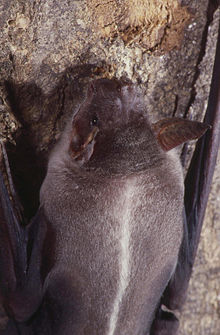Bulldog bat
| Bulldog bats Temporal range: Miocene to Recent
| |
|---|---|

| |
| Greater bulldog bat (Noctilio leporinus) | |
| Scientific classification | |
| Domain: | Eukaryota |
| Kingdom: | Animalia |
| Phylum: | Chordata |
| Class: | Mammalia |
| Order: | Chiroptera |
| Suborder: | Yangochiroptera |
| Superfamily: | Noctilionoidea |
| Family: | Noctilionidae Gray, 1821 |
| Genus: | Noctilio Linnaeus, 1766 |
| Type species | |
| Noctilio americanus | |
| Species | |
|
| |
The
Description
The bulldog bats have orange to brown fur, and range in head-body length from 7 to 14 cm and weight of 20-75 g, which makes them quite large. They have relatively long legs, large feet (exceptionally so in the case of the greater bulldog bat), and strong claws. Their wings are long (up to 60 cm in spread) and narrow, and their ears are large, funnel shaped and pointed. Unusual among bats, they have cheek-pouches for storing food. They also have full lips divided by a fold of skin giving a 'hare lip' look which together with the cheek pouches gives them their bulldog-like appearance.
Their maxillae and premaxillae are fused for the strong support of the large upper medial incisors. Dental formula: 2/1, 1/1, 1/2, 3/3 = 28. The molars are tuberculosectorial. Unlike in other bats, the last cervical vertebra is not fused with the first thoracic. The wing second finger has a long metacarpal and a vestigial phalanx. The ischia are fused to each other and to the sacrum. The latter is keel-like. [5]
Ecology and behaviour
The species of lesser bulldog bats are insectivorous, and while the greater bulldog bats also eat insects, their chief food is fish.[6] They use their echolocation to pinpoint the ripples they make on the surfaces of water.[7]
The greater bulldog bat trawls the water with its long, curved talons approximately 2–3 cm below the surface. It makes sweeps of between 30 cm and 3 m before ascending and turning to make a return sweep. In a single night, the bat may catch 20-30 small fish in this way.[8]
References
- OCLC 62265494.
- ^ Naish, Darren. "Fossil Bat Stories, Part 3: Bulldog Bats".
- ^ ISSN 1439-0310.
- ^ JSTOR 1382280.
- ISBN 0-7216-9009-2.
- ISBN 978-0-19-956799-7p466
- ISBN 978-0-87196-871-5.
- Greenwood Press.
